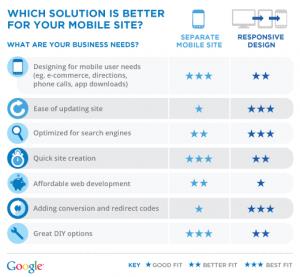What’s the right solution?
As more competitors go mobile (“Go Mo”), building a mobile-friendly site is becoming more of a priority for businesses. Over the past two years alone, mobile search traffic has increased five-fold. Customers are searching for your business from their mobile phones, and you need to engage them with a mobile experience designed for completing on-the-go tasks from their small screens. Recently many businesses have been asking us about an emerging trend among web developers—responsive design—and if they should use it. Whilst building a separate mobile website is an appropriate solution for certain businesses, it’s also important to understand how responsive design might fit into your plans to Go Mo.
 A responsive design is a website design technique that allows you to create a single website that will adapt to the device on which it’s being viewed, whether it’s a laptop, smartphone or tablet. A site built with responsive design will automatically resize for different devices, but it is up to you to prioritize the content that matters most to the mobile user. For example, a mobile user might need to quickly find your phone number or directions, whereas a tablet user might want a simpler way to make couch-surfing purchases. A site built using responsive design could prioritize click-to-call and click-to-map buttons, while the tablet site would focus on simplifying a shopping cart.
A responsive design is a website design technique that allows you to create a single website that will adapt to the device on which it’s being viewed, whether it’s a laptop, smartphone or tablet. A site built with responsive design will automatically resize for different devices, but it is up to you to prioritize the content that matters most to the mobile user. For example, a mobile user might need to quickly find your phone number or directions, whereas a tablet user might want a simpler way to make couch-surfing purchases. A site built using responsive design could prioritize click-to-call and click-to-map buttons, while the tablet site would focus on simplifying a shopping cart.
So how do you know if you should build a separate mobile website or use responsive design?
See if this infographic helps you decide what makes sense for your business:
You don’t necessarily have to rebuild your website from scratch. A sophisticated web developer might be able to adapt an existing site with responsive design, but you will obviously have to pay for their time to carry out the work unless you can do it yourself. And you don’t have to worry about your site getting overly complicated. If done right, your site should still have the same URL for desktop, mobile and tablets. When building a separate mobile optimized site, typically there is a different mobile url, but users are automatically redirected. Have a look at the BBC website on your mobile for a perfect example.
Responsive design can definitely minimize long term maintenance of your site, but many businesses can effectively connect with their customers with a separate mobile-friendly site. If you have the technical resources and a clear business need, then responsive design is a more advanced way to make your site mobile-friendly. No matter how you go about it, you need to ensure you are designing for mobile first, and engaging your customers when they’re using their mobile phones to search for your business.
For additional resources on the value of mobile and testing your site to see how mobile-friendly it is, visit howtogomo.com. If you need anymore help than that, ask your existing developer or someone like me if technical things aren’t your bag!


